Introduction to Astronomy
Stellar Death Match I: Planetary Nebulae
Now, all along, I've been saying that there are two ways for stars to die. The first is by supernova (a huge explosion!), which happens to stars with masses greater than 8 times the mass of the sun. Stars less massive than 8 solar masses die in another way entirely. These stars spend a long time in the upper half of the H-R diagram, and a lot happens to them while they are there. Once the star finishes all of the hydrogen in it's core, it cools, and swells a little bit, moving up to the Red Giant part of the H-R Diagram.
As the core collapses, the helium 'ash' left behind from burning hydrogen eventually ignites. At about the same time, a shell of hydrogen also ignites. This is the "core helium burning phase", because it's the phase during which helium is burning in the core.
Here's a picture of a star in this stage. Notice how much simpler it is than the high mass star---there are only three layers here because the pressure and the density inside never get high enough to fuse carbon or oxygen into other elements.
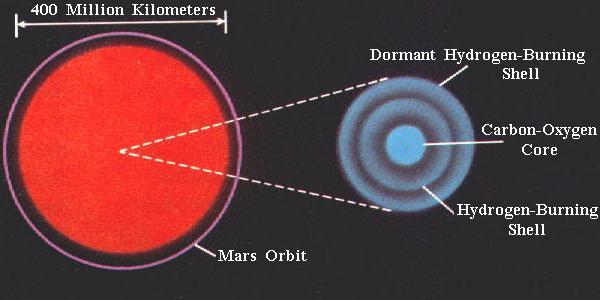 These stars move around quite a bit at the top of the HR diagram, as you can see:
These stars move around quite a bit at the top of the HR diagram, as you can see:

- Red Giant Branch: When the star leaves the main sequence, it enters the red giant branch, where it is burning helium in the core and hydrogen in a shell outside. The helium burning expands the core, and therefore cools the hydrogen burning shell. The star increases in luminosity (becomes brighter), and cools slightly as it expands (becomes redder).
- The Horizontal Branch: The star burns He in the core, and H in a shell surrounding the core. Now there are two sources of energy for the star. The stars become hotter and smaller during this phase, and move across the H-R diagram from right to left. (Staying at about the same luminosity because even though they are hotter, they are smaller.) This is called the Horizontal Branch.
- Pulsating stars: As stars move across the Horizontal Branch, some of them begin to pulsate. These pulsating stars change in size, growing bigger and smaller, and bigger and smaller. It's almost as though they are breathing. You can think about a star as a battleground between energy production and gravity. There is a perfect size for a star, when these two forces are equally balanced. If energy production drops off inside, gravity begins to win, and the star begins to collapse. As the particles move toward the center, they gather momentum, and are moving to fast to stop immediately when they reach the equilibrium point. They overshoot the 'right' size, slow down, and get pushed back out. Once again they gain momentum and overshoot the 'right' size. The star pulsates, getting bigger and smaller as it tries to reach the 'right' size. These stars are found on the instability strip, which crosses the horizontal branch vertically on the H-R diagram.
There are two kinds of pulsating stars:
- Cepheid variables: These stars make good standard candles, because there is a period-brightness relationship. REMEMBER THE LAB! This means that cepheids with the same period have the same luminosity. So if I look at a star in a distant galaxy, and I notice that it's a Cepheid by looking at the light curve, then I can also measure the period, and from that get the brightness---the real, actual brightness, not the distance-dependent apparent magnitude. BUT, I also have the apparent magnitude in hand, just from observing, so I can determine the distance to the star! This is one application of the 'brightness standard candle' method of finding the distance. "All objects of a particular type have the same luminosity, so fainter ones are more distant." In this case, "objects of a particular type" are cepheids with the same period.
- RR Lyrae stars: These stars are small and dim, and we don't care about them, except to know that they are a good way to find the distance to globular clusters. This is done similarly to the cepheid method. We will try this ourselves in a future lab.
Eventually, the star runs out of He in the core. It moves back across the Horizontal Branch as the temperature falls, and back into the Red Giant part of the H-R diagram.
- Now you have a lump of carbon, left over from burning helium in the core, surrounded by a burning hydrogen shell.
- He builds up in a ring around the (mostly) Carbon core, until there's enough of it at high enough pressure to ignite. It burns, puffing up the star (two sources of energy inside), then stops burning as the pressure drops.
- He builds, then burns, then builds, then burns, in a series of thermal pulses. So the star doesn't smoothly increase in luminosity, but instead, takes two steps forward and one step back. In massive stars, these pulses happen deep inside, and don't have much effect on the external luminosity. However, in lower-mass stars (of order 1 MSun), the luminosity will increase by about a factor of 10 for 100 years every 100,000 years. (did you get that? better read it again).
- The mass of the core increases as this goes on.
- A wind develops, and the mass losing phase begins: the star begins to lose mass at a phenomenal rate (as much as 10-5 solar masses per year. At this rate, the entire sun would disappear in only 10,000 years. (an astronomically short period of time!) What drives the mass loss? i.e. what powers the wind? We don't know, but I'm working on it.
- This mass lost moves away from the star, and forms a shell around it. Theory predicts that the shell should be spherical, but usually it's not. We don't know why, but I'm working on it!
- As the mass leaves the star, it exposes hotter and hotter depths. The central star gets bluer and bluer, until it is emitting in mostly the UV. This UV light ionizes the dust and gas that was lost, which then glows.
- The star winds up as a "planetary nebula" surrounding a white dwarf.
- The nebula gradually spreads out, getting thinner and thinner until you can't tell where it stops and where the ordinary stuff between the stars begins.
One of the outstanding questions in planetary nebula astronomy today is 'How do they get their freaky shapes?', which is a great excuse to show some pretty pictures!
Abell 39 looks like something that might have come from a round star:
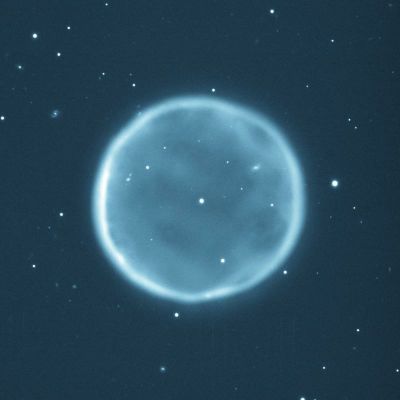 And for a long time, we thought this was what they all looked like. Several close one, like the Dumbbell Nebula:
And for a long time, we thought this was what they all looked like. Several close one, like the Dumbbell Nebula:
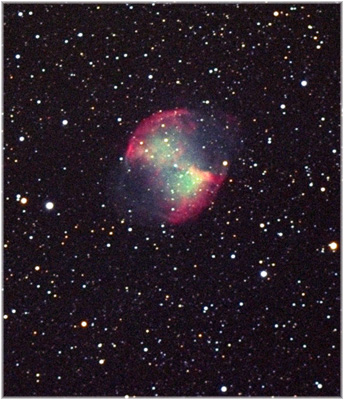 made us think they were all round-ish.
But then, after Hubble Space Telescope was launched, we began to get detailed pictures of nebulae that looked round from the ground. For example, the Eskimo nebula:
made us think they were all round-ish.
But then, after Hubble Space Telescope was launched, we began to get detailed pictures of nebulae that looked round from the ground. For example, the Eskimo nebula:
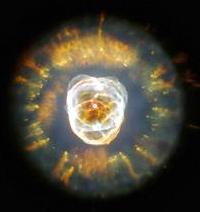 and the Stingray Nebula:
and the Stingray Nebula:
 while not quite exactly round, are sort of round. These can be explained away by small deviations of the central star---maybe it had spots or planets or something that broke the symmetry of the mass loss. But then, you see pictures of the Egg nebula, M2-9, or craziest of all, Mycn18:
while not quite exactly round, are sort of round. These can be explained away by small deviations of the central star---maybe it had spots or planets or something that broke the symmetry of the mass loss. But then, you see pictures of the Egg nebula, M2-9, or craziest of all, Mycn18:
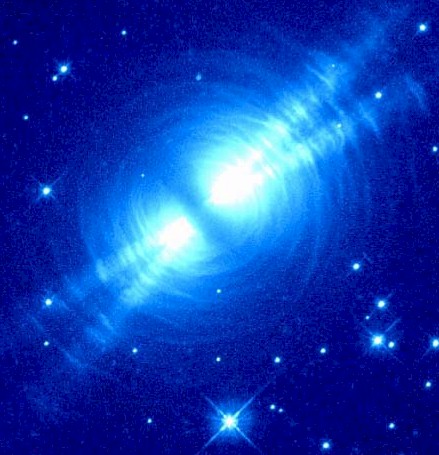
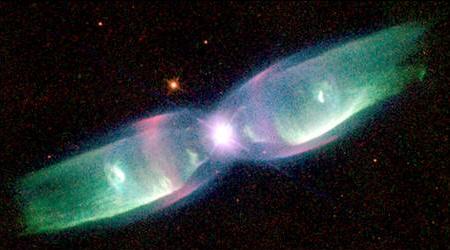
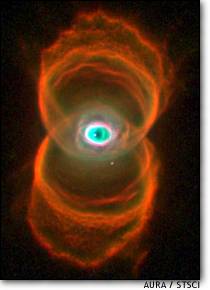 and you suddenly realize that we HAVE NO IDEA what's going on! At the moment, the top two explanations are
a) Planets around these stars make the mass loss 'funny'.
b) Magnetic fields around these stars make a disk around the equator of the star that in turn, makes the mass loss 'funny'.
Recent discoveries of massive, close-in extra-solar planets made (a) the favorite for a while, in spite of the fact that the models are not as good at creating REALLY wacky shapes as one might like. Even more recently, magnetic fields have been discovered in mycn18, lending support to explanation (b). The jury is still out though, and astronomers meet every couple of years to discuss the problem, and try to figure out the answer. Eventually, we'll get it figured out!
and you suddenly realize that we HAVE NO IDEA what's going on! At the moment, the top two explanations are
a) Planets around these stars make the mass loss 'funny'.
b) Magnetic fields around these stars make a disk around the equator of the star that in turn, makes the mass loss 'funny'.
Recent discoveries of massive, close-in extra-solar planets made (a) the favorite for a while, in spite of the fact that the models are not as good at creating REALLY wacky shapes as one might like. Even more recently, magnetic fields have been discovered in mycn18, lending support to explanation (b). The jury is still out though, and astronomers meet every couple of years to discuss the problem, and try to figure out the answer. Eventually, we'll get it figured out!
Concept Question 1:
The sun will die as a planetary nebula because
- it has only one solar mass.
- it is small enough.
- it is faint enough.
- it won't! The Sun will die as a supernova.
Concept Question 2:
The winds from evolved stars are started by
- Radiation pressure.
- Gravitational contraction of the core.
- Line-driving.
- We don't really know yet.
Concept Question 3:
Planetary nebulae suddenly become visible when they are exposed to lots of UV radiation from the core. This happens suddenly because
- the star gains mass, and thus becomes hotter.
- deeper and hotter layers of the star are exposed as mass is lost.
- the star begins burning carbon, and thus becomes hotter.
- We don't really know yet.


















 These stars move around quite a bit at the top of the HR diagram, as you can see:
These stars move around quite a bit at the top of the HR diagram, as you can see:

 And for a long time, we thought this was what they all looked like. Several close one, like the Dumbbell Nebula:
And for a long time, we thought this was what they all looked like. Several close one, like the Dumbbell Nebula:
 made us think they were all round-ish.
But then, after Hubble Space Telescope was launched, we began to get detailed pictures of nebulae that looked round from the ground. For example, the Eskimo nebula:
made us think they were all round-ish.
But then, after Hubble Space Telescope was launched, we began to get detailed pictures of nebulae that looked round from the ground. For example, the Eskimo nebula:
 and the Stingray Nebula:
and the Stingray Nebula:
 while not quite exactly round, are sort of round. These can be explained away by small deviations of the central star---maybe it had spots or planets or something that broke the symmetry of the mass loss. But then, you see pictures of the Egg nebula, M2-9, or craziest of all, Mycn18:
while not quite exactly round, are sort of round. These can be explained away by small deviations of the central star---maybe it had spots or planets or something that broke the symmetry of the mass loss. But then, you see pictures of the Egg nebula, M2-9, or craziest of all, Mycn18:


 and you suddenly realize that we HAVE NO IDEA what's going on! At the moment, the top two explanations are
a) Planets around these stars make the mass loss 'funny'.
b) Magnetic fields around these stars make a disk around the equator of the star that in turn, makes the mass loss 'funny'.
Recent discoveries of massive, close-in extra-solar planets made (a) the favorite for a while, in spite of the fact that the models are not as good at creating REALLY wacky shapes as one might like. Even more recently, magnetic fields have been discovered in mycn18, lending support to explanation (b). The jury is still out though, and astronomers meet every couple of years to discuss the problem, and try to figure out the answer. Eventually, we'll get it figured out!
and you suddenly realize that we HAVE NO IDEA what's going on! At the moment, the top two explanations are
a) Planets around these stars make the mass loss 'funny'.
b) Magnetic fields around these stars make a disk around the equator of the star that in turn, makes the mass loss 'funny'.
Recent discoveries of massive, close-in extra-solar planets made (a) the favorite for a while, in spite of the fact that the models are not as good at creating REALLY wacky shapes as one might like. Even more recently, magnetic fields have been discovered in mycn18, lending support to explanation (b). The jury is still out though, and astronomers meet every couple of years to discuss the problem, and try to figure out the answer. Eventually, we'll get it figured out!